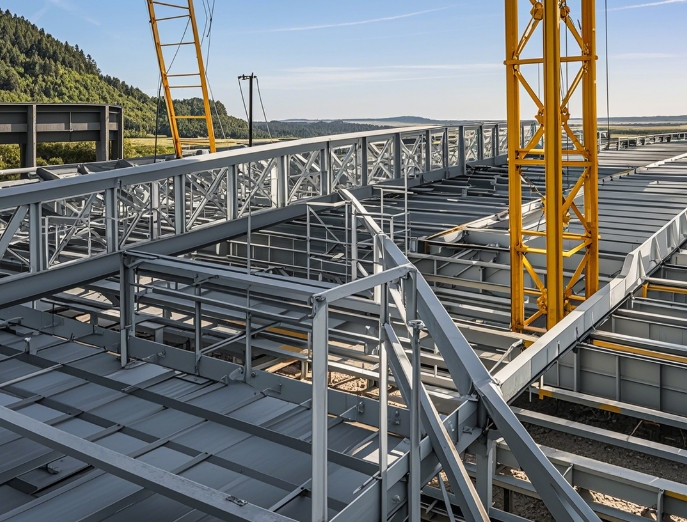文件 图片 11/10000 实时翻译 File Image 11/10000 Real time Translation Introduction to the Selection Method
更新时间:2025-02-21 16:07:35•点击:326100 • Grid Knowledge
Introduction to the selection method of grid structure
In the field of modern architecture, grid structures are widely used in large-span building projects such as sports halls, exhibition halls, and terminals due to their excellent spatial performance, strong load-bearing capacity, and flexible styling characteristics. The selection of grid structure is directly related to the safety, economy, and aesthetics of the building, and is a key link in the process of building design and construction. Below are several scientific and practical methods for selecting grid structures.Selection based on building functionality and spatial requirements
The functional positioning and spatial planning of buildings are the primary considerations for selecting grid structures. For large public buildings such as sports halls and exhibition halls that pursue open and column free spaces, it is necessary to choose a grid structure with superior spatial stress performance and high stiffness. The upright square pyramid grid is one of the ideal choices, with uniform force distribution and regular grid layout. When applied in buildings with a plane close to a square, it can efficiently transfer roof loads to the supporting structure, ensuring stable use of large spaces. The triangular pyramid truss, with its higher spatial stiffness, is suitable for building scenarios with larger spans and more complex load conditions, such as the roofs of large sports venues. It can withstand huge roof and wind loads while ensuring the long-term stability of the structure.
Select based on the shape of the building plan
The planar shape of a building has a significant impact on the selection of grid structures. When the building plan is rectangular, the aspect ratio is a key decision-making indicator. If the aspect ratio is less than 1.5, both the upright and inclined four corner pyramid grid structures are feasible solutions. The upright square pyramid grid structure is simple in structure, with low construction difficulty, and can effectively control construction costs; The inclined quadrangular pyramid grid has better stiffness performance and is suitable for buildings that can withstand large loads. When the aspect ratio is greater than 1.5, the two-way orthogonal upright grid can better adapt to the stress characteristics of the rectangular plane, and through reasonable arrangement of members, achieve uniform load transmission and ensure the safety of the structure.
Select based on span size
Span is one of the core parameters for selecting grid structures. In small span (generally less than 30 meters) construction projects, the use of cross beam grid structures can be given priority consideration. This type of grid structure has simple construction, low material usage, and low cost, which can meet the functional requirements of general small span buildings. For buildings with medium spans (30-60 meters), upright square pyramid grid and evacuated square pyramid grid are commonly used choices. By optimizing the arrangement of members, the hollow four cone grid reduces the number of members and lowers material costs while ensuring the mechanical performance of the structure. It is particularly suitable for projects with high economic requirements. When the span is greater than 60 meters, in order to ensure that the structure has sufficient rigidity and bearing capacity, triangular pyramid grid, honeycomb triangular pyramid grid, etc. can be selected. These grid structures greatly enhance the spatial stiffness of the structure through complex and sophisticated combinations of spatial members, which can effectively cope with the huge load challenges brought by large spans.
Selection based on economic factors
Economy is an important factor that cannot be ignored in the selection of grid structures, while meeting the requirements of building functionality and structural safety. On the one hand, material costs should be considered by optimizing the cross-sectional dimensions and layout of the members to reduce the amount of steel used; On the other hand, construction costs cannot be ignored. For example, the installation of bolted ball joints is convenient, which can significantly shorten the construction period and reduce labor costs; Although the welded ball joint has good overall integrity, the welding workload is large and the construction cost is relatively high. In project practice, it is necessary to comprehensively weigh material costs and construction costs, and choose the most economical and reasonable form of grid structure.
The selection of grid structure is a comprehensive decision-making process that requires comprehensive consideration of various factors such as building function, plan shape, span size, and economy. Only through scientific and rigorous analysis and comparison can the most suitable grid structure be selected for each building project, achieving a perfect unity of building function, structural safety, and economic benefits.
Recommended Reading
-
Full analysis of seismic design and maintenance of grid structure
2025-02-27 16:16:52•1194773 次
-
What are the key process points to follow in order to ensure the quality of grid processing?
2025-02-27 11:21:00•115619 次
-
What type of construction is the grid mainly suitable for?
2025-02-25 16:42:00•111889 次
-
Quality control requirements of grid manufacturers!
2025-02-25 16:02:44•208056 次







